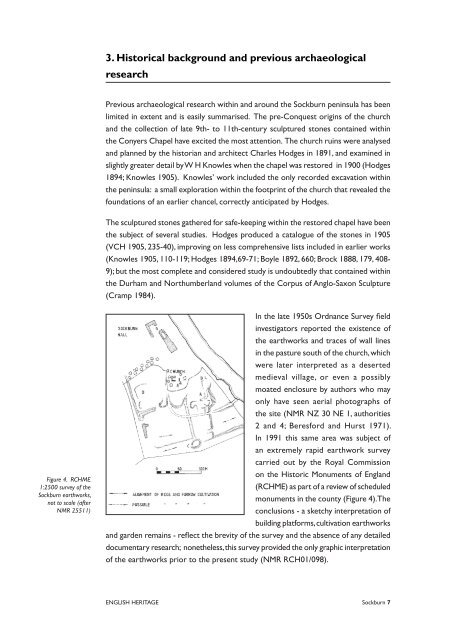Sockburn Hall, Darlington: an archaeological ... - English Heritage
Sockburn Hall, Darlington: an archaeological ... - English Heritage
Sockburn Hall, Darlington: an archaeological ... - English Heritage
Create successful ePaper yourself
Turn your PDF publications into a flip-book with our unique Google optimized e-Paper software.
Figure 4. RCHME<br />
1:2500 survey of the<br />
<strong>Sockburn</strong> earthworks,<br />
not to scale (after<br />
NMR 25511)<br />
. Historical background <strong>an</strong>d previous <strong>archaeological</strong><br />
research<br />
Previous <strong>archaeological</strong> research within <strong>an</strong>d around the <strong>Sockburn</strong> peninsula has been<br />
limited in extent <strong>an</strong>d is easily summarised. The pre-Conquest origins of the church<br />
<strong>an</strong>d the collection of late 9th- to 11th-century sculptured stones contained within<br />
the Conyers Chapel have excited the most attention. The church ruins were <strong>an</strong>alysed<br />
<strong>an</strong>d pl<strong>an</strong>ned by the histori<strong>an</strong> <strong>an</strong>d architect Charles Hodges in 1891, <strong>an</strong>d examined in<br />
slightly greater detail byW H Knowles when the chapel was restored in 1900 (Hodges<br />
1894; Knowles 1905). Knowles’ work included the only recorded excavation within<br />
the peninsula: a small exploration within the footprint of the church that revealed the<br />
foundations of <strong>an</strong> earlier ch<strong>an</strong>cel, correctly <strong>an</strong>ticipated by Hodges.<br />
The sculptured stones gathered for safe-keeping within the restored chapel have been<br />
the subject of several studies. Hodges produced a catalogue of the stones in 1905<br />
(VCH 1905, 235-40), improving on less comprehensive lists included in earlier works<br />
(Knowles 1905, 110-119; Hodges 1894,69-71; Boyle 1892, 660; Brock 1888, 179, 408-<br />
9); but the most complete <strong>an</strong>d considered study is undoubtedly that contained within<br />
the Durham <strong>an</strong>d Northumberl<strong>an</strong>d volumes of the Corpus of Anglo-Saxon Sculpture<br />
(Cramp 1984).<br />
In the late 1950s Ordn<strong>an</strong>ce Survey field<br />
investigators reported the existence of<br />
the earthworks <strong>an</strong>d traces of wall lines<br />
in the pasture south of the church,which<br />
were later interpreted as a deserted<br />
medieval village, or even a possibly<br />
moated enclosure by authors who may<br />
only have seen aerial photographs of<br />
the site (NMR NZ 30 NE 1, authorities<br />
2 <strong>an</strong>d 4; Beresford <strong>an</strong>d Hurst 1971).<br />
In 1991 this same area was subject of<br />
<strong>an</strong> extremely rapid earthwork survey<br />
carried out by the Royal Commission<br />
on the Historic Monuments of Engl<strong>an</strong>d<br />
(RCHME) as part of a review of scheduled<br />
monuments in the county (Figure 4).The<br />
conclusions - a sketchy interpretation of<br />
building platforms,cultivation earthworks<br />
<strong>an</strong>d garden remains - reflect the brevity of the survey <strong>an</strong>d the absence of <strong>an</strong>y detailed<br />
documentary research; nonetheless,this survey provided the only graphic interpretation<br />
of the earthworks prior to the present study (NMR RCH01/098).<br />
ENGLISH HERITAGE <strong>Sockburn</strong>

















